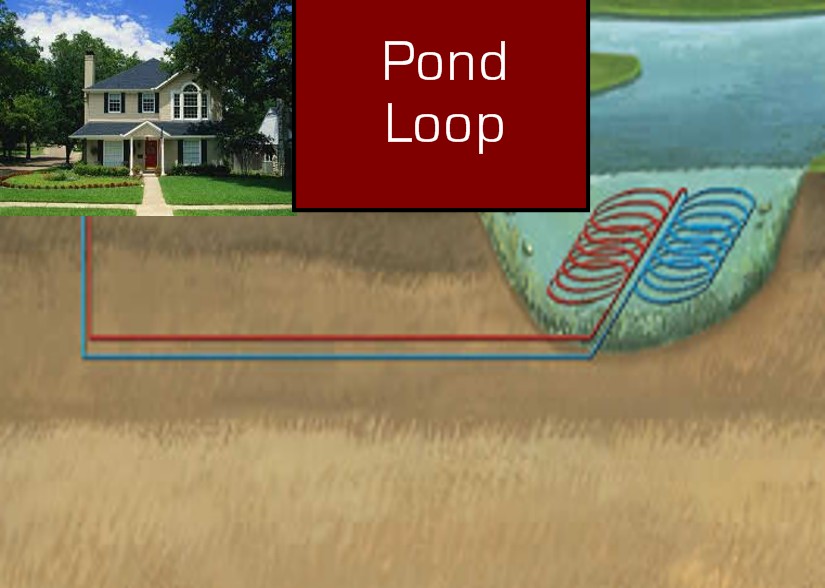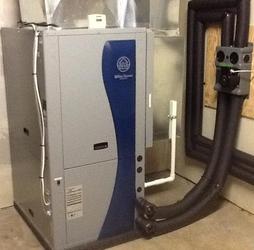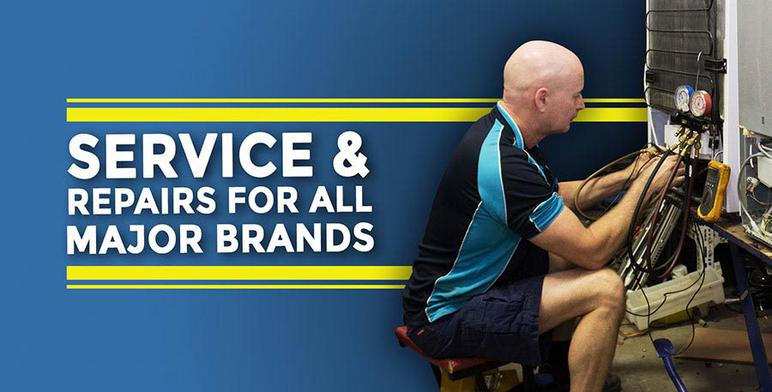About Geothermal
Get Started Today!
How Much Can You Save?
The GeoThermal Process
There are three basic elements of a GeoThermal GSHP system:
- Ground Loop — A system of fluid-filled HDPE pipes buried in the ground or sometimes in a body of water, near the building.
- Water Furnace — A Geo GSHP unit which transfers the 57 degrees absorbed by the Ground Loop & manipulates it to heat or cool the building.
- Delivery System — Conventional ductwork used to distribute the conditioned air throughout the building or hydronic delivery by heated water.
Simply put, a Geothermal Geothermal GSHP system works much like the refrigerator in your kitchen, with the addition of a few extra valves that allow heat-exchange fluid to follow two different paths: one for heating and one for cooling. The GSHP, using the Ground Loop, moves the 57 degrees from the ground into the Water Furnace which then manipulates it to either heat or cool your building. Since a GSHP both heats and cools with only one indoor unit there is no more need for that noisy outdoor A/C unit ... and a natural byproduct of the process is free hot water heating during the summer.
Geothermal GSHP systems still use a small amount of electricity to run the pump, compressor & fan. However, it delivers $5 of energy for every $1 of electricity purchased. Unlike a conventional heat pump system, a GEO system use the relatively constant temperature of the earth as the source of heat in the winter and as a heat-sink repository for heat in the summer.
In the winter, the water passing through the underground (or underwater) sealed Ground Loop is warmed by the earth's heat. The collected heat is extracted and concentrated by the GSHP and distributed through the building's ductwork or hydronic delivery system.
To cool the building in the summer, this process is reversed — the heat pump collects heat from the indoor air and moves it into the Ground Loop where it is absorbed by the relatively cooler ground. The heat removed from the indoor air during the summer can also be used to produce free hot water.

The Earth's Stored Energy
The earth absorbs an amazing 46% of the sun's energy, leaving a fairly constant underground temperature between 45° and 70° F. In the mid-atlantic area the average constant tepurature is 57° F.
The Ground Loop
By creating a heat exchanger, also known as the Ground Loop System, the stored solar energy in the ground can be harnessed and delivered to the GeoThermal GSHP system in the building. The entire Ground Loop system is installed and enters the building below the surface grade.
Vertical Loop
Since most projects, either new or retrofit, have limited land area the vertical loop is the most commonly used. A drilling rig is used to bore holes at of depth of 150 to 450 feet. A U-shaped coil of high density pipe is inserted into the bore hole. The holes are then backfilled with a grout type sealing solution.
The Vertical Loop delivers the best conductivity, requires the smallest area footprint and is generally the loop of choice for most retrofit projects.


Horizontal Loop
When adequate land area is available the horizontal loop is used for new construction or retrofit applications of existing buildings. Depending on the loop design and application for your customized GeoThermal system, pipe trenches are prepared ranging in size from 5 to 8 feet deep and 100 to 300 feet long.

Pond Loop
This loop is an option if a body of water 8 to 10 feet deep and 1/2 acre in size is available within approximately 200 feet of the home. Several coils of pipe typically 300 to 500 feet in length each are placed in and anchored to the bottom of the body of water.

Open Loop
This system application is available if an abundant supply of high quality well water is available with a minimum of 4 to 8 gallons of consistent water per minute. An approved proper discharge area such as a river, drainage ditch, field tile, stream, pond, or lake must be available within a reasonable distance from the building. Many municipalities no longer approve this pump & dump type application.
The Water Furnace a GeoThermal GSHP
A GeoThemal GSHP is a central heating and cooling unit that pumps heat both from the ground and back into the ground. It uses the earth as a heat source (in the winter) or a heat sink (in the summer). These units are known by a variety of names including geoexchange, earth-coupled, earth energy or water-source heat pumps.
The core of the Water Furnace is the Ground Loop Exchange System. Using the flowing water from the Ground Loop, exchanging the temperature with the refrigerant and then sending it through a vapor-compression cycle, heat is moved into (during the winter) and out of (during the summer) the conditioned air in the building.
Unlike a conventional air-source heat pump, which transfers heat to or from the outside air, a GeoThermal GSHP transfers heat with the ground. GeoThermal GSHP systems are the most energy efficient space conditioning technology available.

The Delivery System
The heat may be carried to its end use by either circulating water (hydronic heated floors or baseboard) or forced air (duct system). A Liquid-to-Water GSHP is a hydronic system unit that use water to carry heating or cooling through the building. Systems such as radiant underfloor heating, baseboard radiators and conventional cast iron radiators would use a liquid-to-water GSHP. A Liquid-to-Air GSHP delivers forced air, and are most commonly used to replace forced air furnaces and central air conditioning systems.
For water heating, you can add a desuperheater to a Geothermal Water Furnace. A desuperheater is a small, auxiliary heat exchanger that uses the superheated gases from the GSHP compressor to heat water. This hot water then circulates to the building's storage water heater tank.

The Benefits of Geothermal
Significant Savings & Added Property Value
Savings of 40% to 80% on utility bills from day one is the greatest benefit of a GeoThermal GSHP system. From the moment your GeoThermal GSHP system is installed, it is saving you money. As an added bonus they also have the ability to provide domestic hot water at a savings in water heating costs of up to 100%. These systems can significantly increase property and resale values. An average estimate of increased market value is $20 for every $1 of annual utility bill savings.
High Energy Efficiency
The efficiency of GeoThermal GSHP systems make them highly cost-effective in both operation and maintenance costs. These systems transfer energy to and from the ground. The cost of electricity for the circulation pump, compressor and fan are the only electricity required. Only one unit of electricity is used to move at least four units of heat from the Earth, the efficiency of the GeoThermal GSHP system often surpass 500%!
Greater Comfort & Quiet Operation
The super-efficient dual-stage compressor and soft-start variable-speed fan, are responsible for making GeoThermal GSHP systems extremity quiet. As opposed to a conventional furnace, there are no cycles with extreme blasts of hot or cold air and no major temperature fluctuations. They maintain a more consistent temperature throughout the building, In summer, GeoThermal GSHP systems provide enhanced comfort. They don’t dry out the air as much as conventional A/C systems by maintaining a 45% relative indoor humidity.
Exterior Equipment is Eliminated
The GeoThermal GSHP unit is contained indoors replacing your existing HVAC system. The loud, ugly outdoor equipment associated with conventional systems is eliminated.
Versitile, Flexible Installation
Configurations and outputs for virtually any climate & structure size are available for GeoThermal GSHP systems. They can be installed on almost any size lot, under lawns, landscaped areas, driveways, parking lots, or the structure itself. Existing homes or buildings can be retrofitted with a GSHP system using the same ductwork or hydronic piping already in place.
Reliabillity with Minimal Maintenance Expense
The GeoThermal GSHP units have extremely long service lives of 25+ years and under normal use only require periodic checks and filter changes. The other half of the system, the earth loop located in the ground, is 100% maintenance free, will never freeze, and carries a 50+ year warranty.
Environmentally Friendly
According to the Department of Energy's Geothermal Technologies Program, the average residential dwelling contributes more greenhouse gas emissions than most cars. GeoThermal GSHP systems emit no carbon dioxide, carbon monoxide, or other greenhouse gasses, and have the lowest emissions among all heating and cooling technologies. They do not contain any chlorofluorocarbons (CFCs), which are suspected to be a major cause of ozone depletion.
Consumer Satisfaction
Surveys of GeoThermall users conducted by utility companies nationwide indicate much higher levels of consumer satisfaction for GSHP systems over conventional systems. Polls consistently show that more than 95% of all GeoThermal customers higly recommend GeoThermal to family member or friends.
Frequently Asked Questions
Can a ground-source heat pump system provide 100% of my home's heating and cooling needs?
Yes. Properly sized ground-source GeoThermal GSHP systems can provide 100% of your heating and cooling requirements and at the same time provide domestic hot water. Outside temperatures do not affect GeoThermal GSHP systems. Both hydronic as well as with forced air system delivery is available for new or existing structures.
Are all GSHP systems alike?
No. Each application requires a different GeoThermal GSHP system designs. Most systems provide both heating and cooling. Some systems provide heating, cooling, and hot water. There is no one system that works for every application.
What size system will my home or business require?
Oversized and undersized GeoThermal GSHP systems provide for many problems. An ACCA Manual J heat load calculations should be completed on your home to provide the specific information required to properly size the entire system and give you the most efficient cost effective system to meet your specific needs.
How much space does a GSHP unit require?
Most of the GeoThermal GSHP system, the ground loop, is installed underground. The interior units require the same size footprint of a traditional furnace.
How long do ground-source heat pump systems last and do they carry a good warranty?
A GeoThermal GSHP systems is highly reliable. With only 3 moving parts, service life of the unit is 25+ years under normal use. Many manufacturers offer a 10 year coverage on major parts. The manufacturers of the polyethylene earth loop, used for for the underground heat energy transfer, warrant their product for 50 years. Independent tests show a useful life-span of over 200 years.
Will I have to add insulation or upgrade my windows if I install a GSHP system?
GeoThermal GSHP systems will reduce your heating and cooling costs regardless of how well your home or building is insulated. Research shows that for every $1 spent in building envelope energy efficiency upgrades, $3 is saved in your GeoThermal GSHP systems installation cost. Combining geothermal technology with other energy efficiency measures will maximize your monthly savings and lower your total system installation costs.
Do I need to increase the size of my electrical service?
GeoThermal GSHP systems, as a rule, don’t use large amounts electricity so your existing service should be more than adequate.
Will an underground "earth loop" affect my lawn or landscape?
No. Industry research has shown that GeoThermal earth loops have no adverse effects on grass, trees, or shrubs. Vertical or horizontal earth loops require little space, do not damage lawns significantly, and can be installed in all types of soil varying from sand to hard granite.
Do I need separate "earth loops" for heating and cooling?
No. The same loop works for both. During the cold season the heat is extracted from the ground. In the warm season the heat is transferred back into the ground.
About North American GeoThermal
North American GeoThermal's designers are LoopLink Certified. This symbol lets you know that your system designer has been trained not just by the makers of the industry's best Geothermal design software, but by the authors of the industry standard design and installation manual issued by the International Ground Source Heat Pump Association ( IGSHPA ), the leading national entity for Geothermal GSHP standards, training, and certifications.
North American GeoThermal's well drilling & ground loop team have installed over 1 Million Miles of Geothermal loop pipe. With a team of over 65 Geothermal professionals your Geothermal ground loop installation will be performed by IGSHPA accredited installers and master well drillers, fluent in the complex geological formations found throughout our service area.
North American GeoThermal's interior equipment installers have installed hundreds of systems over more than 25 years. Our installers are WaterFurnace factory trained geothermal certified professionals. Only the best from the WaterFurnace network are invited to become a GeoPro Master Dealer. We have proven time and time again that we truly care about our customers. You can take comfort in the fact that as a GeoPro dealer we have proven ourselves in the following areas:
Overall Performance - Experience and Dedication - Installation Quality Continued Technical Training - Over All Business Practices

Contact North American GeoThermal
Need Service?
When you need fast, effective repair solutions, you can always count on our team at North American GeoThermal!

We use top-class diagnostic services to make sure we locate and remedy your GeoThermal system problems without delay.


